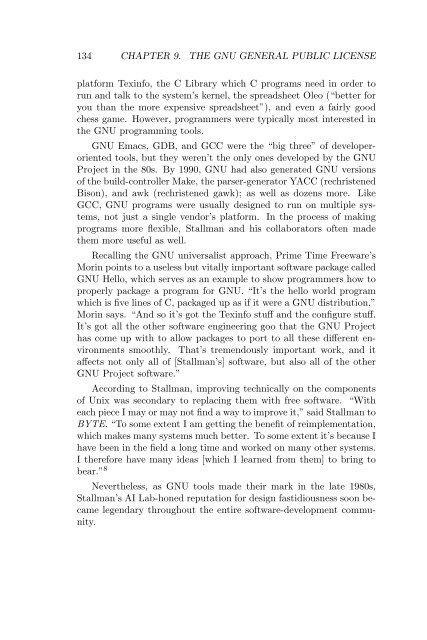You also want an ePaper? Increase the reach of your titles
YUMPU automatically turns print PDFs into web optimized ePapers that Google loves.
134 CHAPTER 9. THE GNU GENERAL PUBLIC LICENSE<br />
platform Texinfo, the C Library which C programs need in order to<br />
run and talk to the system’s kernel, the spreadsheet Oleo (“better for<br />
you than the more expensive spreadsheet”), and even a fairly good<br />
chess game. However, programmers were typically most interested in<br />
the GNU programming tools.<br />
GNU Emacs, GDB, and GCC were the “big three” of developeroriented<br />
tools, but they weren’t the only ones developed by the GNU<br />
Project in the 80s. By 1990, GNU had also generated GNU versions<br />
of the build-controller Make, the parser-generator YACC (rechristened<br />
Bison), and awk (rechristened gawk); as well as dozens more. Like<br />
GCC, GNU programs were usually designed to run on multiple systems,<br />
not just a single vendor’s platform. In the process of making<br />
programs more flexible, Stallman and his collaborators often made<br />
them more useful as well.<br />
Recalling the GNU universalist approach, Prime Time Freeware’s<br />
Morin points to a useless but vitally important software package called<br />
GNU Hello, which serves as an example to show programmers how to<br />
properly package a program for GNU. “It’s the hello world program<br />
which is five lines of C, packaged up as if it were a GNU distribution,”<br />
Morin says. “And so it’s got the Texinfo stuff and the configure stuff.<br />
It’s got all the other software engineering goo that the GNU Project<br />
has come up with to allow packages to port to all these different environments<br />
smoothly. That’s tremendously important work, and it<br />
affects not only all of [Stallman’s] software, but also all of the other<br />
GNU Project software.”<br />
According to Stallman, improving technically on the components<br />
of Unix was secondary to replacing them with free software. “With<br />
each piece I may or may not find a way to improve it,” said Stallman to<br />
BYTE. “To some extent I am getting the benefit of reimplementation,<br />
which makes many systems much better. To some extent it’s because I<br />
have been in the field a long time and worked on many other systems.<br />
I therefore have many ideas [which I learned from them] to bring to<br />
bear.” 8<br />
Nevertheless, as GNU tools made their mark in the late 1980s,<br />
Stallman’s AI Lab-honed reputation for design fastidiousness soon became<br />
legendary throughout the entire software-development community.


